MBA506 Thinking Styles, Negotiation, and Conflict Management Report
VerifiedAdded on 2023/06/12
|8
|1851
|306
Report
AI Summary
This report delves into the relationship between thinking styles and negotiation strategies within the context of a commercial asset purchase scenario, specifically for Farnsworth Property Trust, a subsidiary of Pashendale Holdings Ltd. It begins by outlining four primary thinking styles: monarchic, hierarchic, oligarchic, and anarchic, and contrasting internal and external scopes of thinking. The author identifies with a hierarchic thinking style and an external scope, emphasizing the ability to prioritize multiple goals and collaborate effectively within teams. The report then applies these concepts to a negotiation scenario, discussing the importance of understanding the seller's strengths and weaknesses, setting goals, and considering the Best Alternative To a Negotiated Agreement (BATNA). The author identifies potential modifications to their thinking style and scope to adapt to different situations. Finally, the zone of possible agreement (ZOPA) is analyzed, and strategies for enhancing it are proposed. This report provides a detailed analysis of negotiation dynamics through the lens of individual thinking styles.
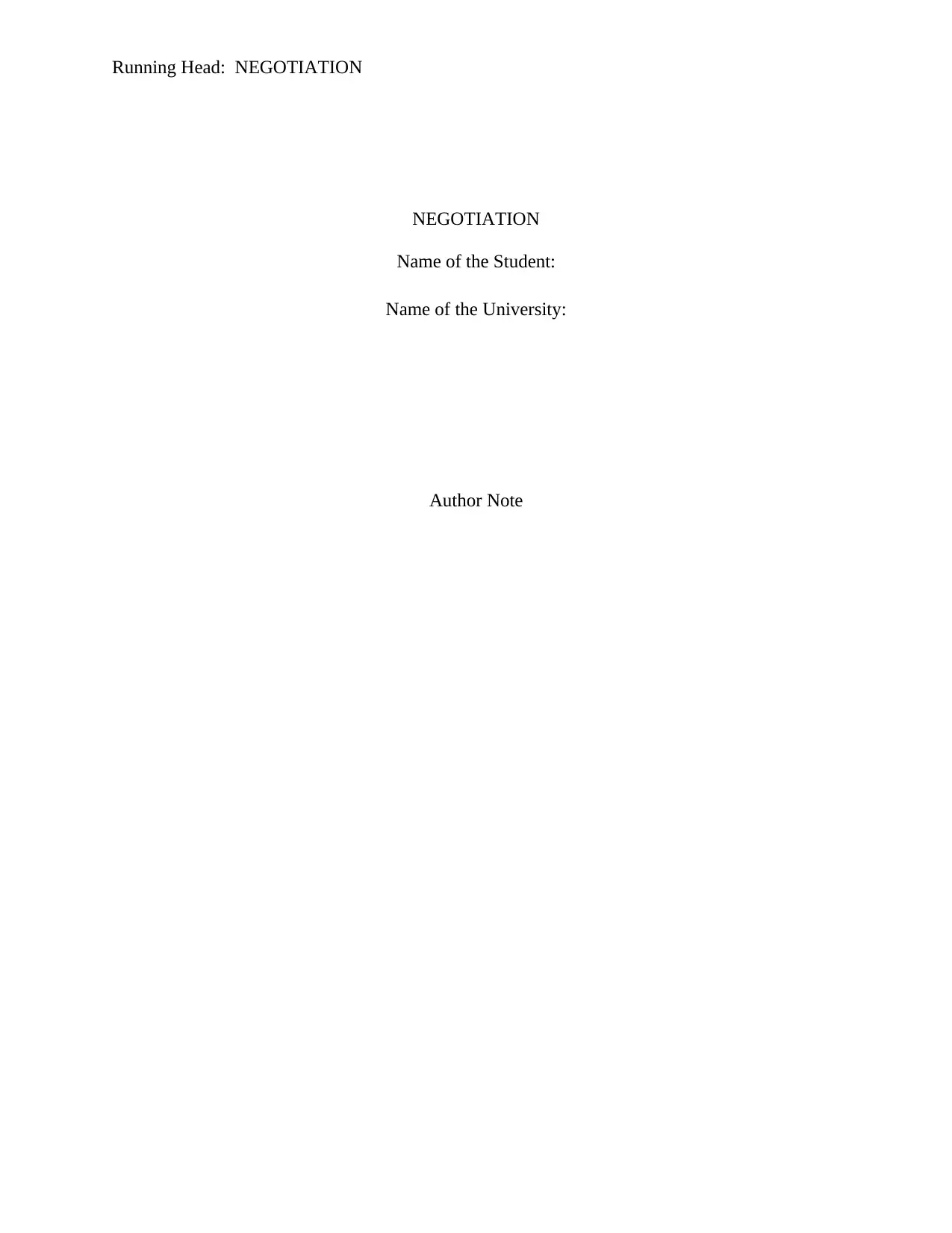
Running Head: NEGOTIATION
NEGOTIATION
Name of the Student:
Name of the University:
Author Note
NEGOTIATION
Name of the Student:
Name of the University:
Author Note
Paraphrase This Document
Need a fresh take? Get an instant paraphrase of this document with our AI Paraphraser
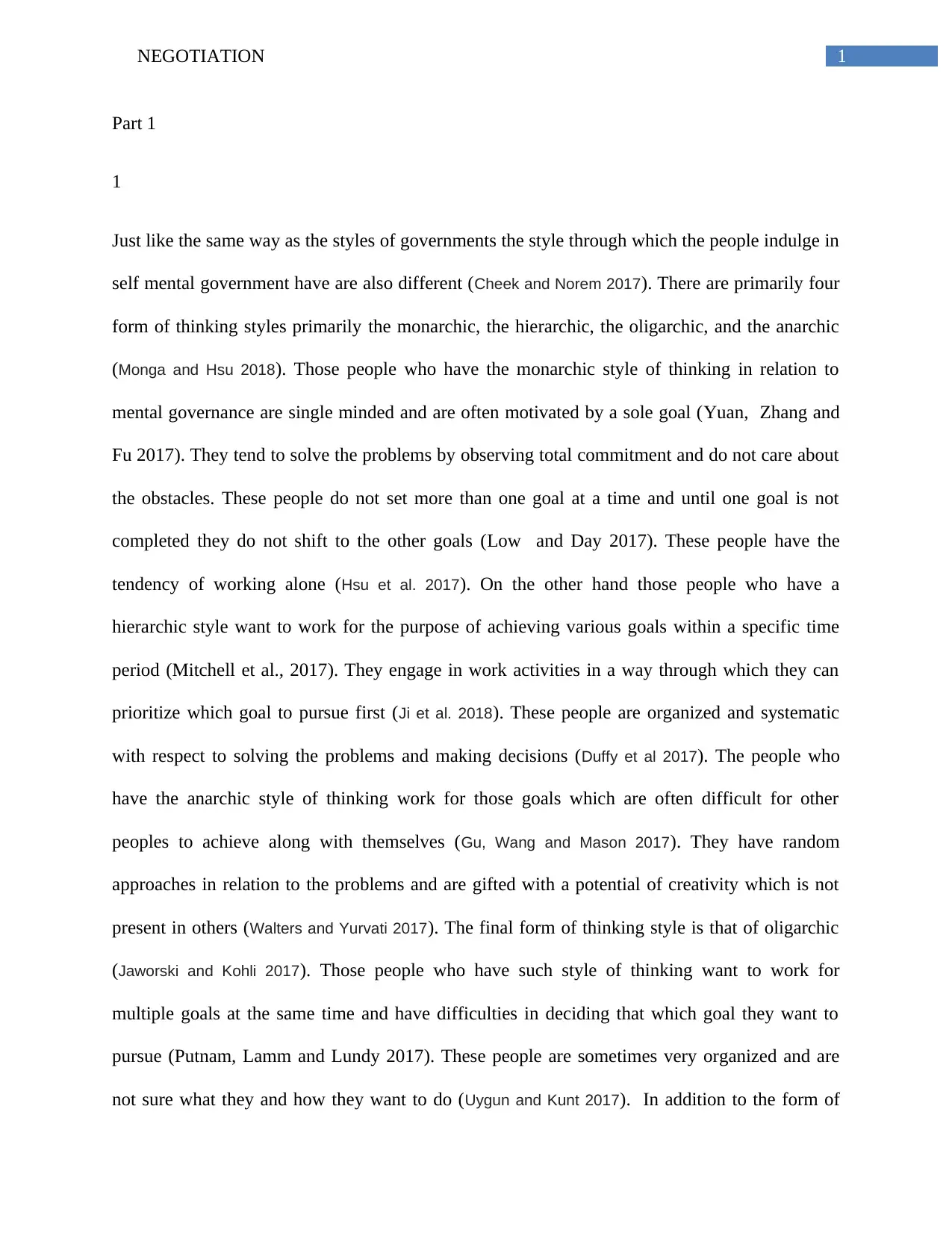
1NEGOTIATION
Part 1
1
Just like the same way as the styles of governments the style through which the people indulge in
self mental government have are also different (Cheek and Norem 2017). There are primarily four
form of thinking styles primarily the monarchic, the hierarchic, the oligarchic, and the anarchic
(Monga and Hsu 2018). Those people who have the monarchic style of thinking in relation to
mental governance are single minded and are often motivated by a sole goal (Yuan, Zhang and
Fu 2017). They tend to solve the problems by observing total commitment and do not care about
the obstacles. These people do not set more than one goal at a time and until one goal is not
completed they do not shift to the other goals (Low and Day 2017). These people have the
tendency of working alone (Hsu et al. 2017). On the other hand those people who have a
hierarchic style want to work for the purpose of achieving various goals within a specific time
period (Mitchell et al., 2017). They engage in work activities in a way through which they can
prioritize which goal to pursue first (Ji et al. 2018). These people are organized and systematic
with respect to solving the problems and making decisions (Duffy et al 2017). The people who
have the anarchic style of thinking work for those goals which are often difficult for other
peoples to achieve along with themselves (Gu, Wang and Mason 2017). They have random
approaches in relation to the problems and are gifted with a potential of creativity which is not
present in others (Walters and Yurvati 2017). The final form of thinking style is that of oligarchic
(Jaworski and Kohli 2017). Those people who have such style of thinking want to work for
multiple goals at the same time and have difficulties in deciding that which goal they want to
pursue (Putnam, Lamm and Lundy 2017). These people are sometimes very organized and are
not sure what they and how they want to do (Uygun and Kunt 2017). In addition to the form of
Part 1
1
Just like the same way as the styles of governments the style through which the people indulge in
self mental government have are also different (Cheek and Norem 2017). There are primarily four
form of thinking styles primarily the monarchic, the hierarchic, the oligarchic, and the anarchic
(Monga and Hsu 2018). Those people who have the monarchic style of thinking in relation to
mental governance are single minded and are often motivated by a sole goal (Yuan, Zhang and
Fu 2017). They tend to solve the problems by observing total commitment and do not care about
the obstacles. These people do not set more than one goal at a time and until one goal is not
completed they do not shift to the other goals (Low and Day 2017). These people have the
tendency of working alone (Hsu et al. 2017). On the other hand those people who have a
hierarchic style want to work for the purpose of achieving various goals within a specific time
period (Mitchell et al., 2017). They engage in work activities in a way through which they can
prioritize which goal to pursue first (Ji et al. 2018). These people are organized and systematic
with respect to solving the problems and making decisions (Duffy et al 2017). The people who
have the anarchic style of thinking work for those goals which are often difficult for other
peoples to achieve along with themselves (Gu, Wang and Mason 2017). They have random
approaches in relation to the problems and are gifted with a potential of creativity which is not
present in others (Walters and Yurvati 2017). The final form of thinking style is that of oligarchic
(Jaworski and Kohli 2017). Those people who have such style of thinking want to work for
multiple goals at the same time and have difficulties in deciding that which goal they want to
pursue (Putnam, Lamm and Lundy 2017). These people are sometimes very organized and are
not sure what they and how they want to do (Uygun and Kunt 2017). In addition to the form of
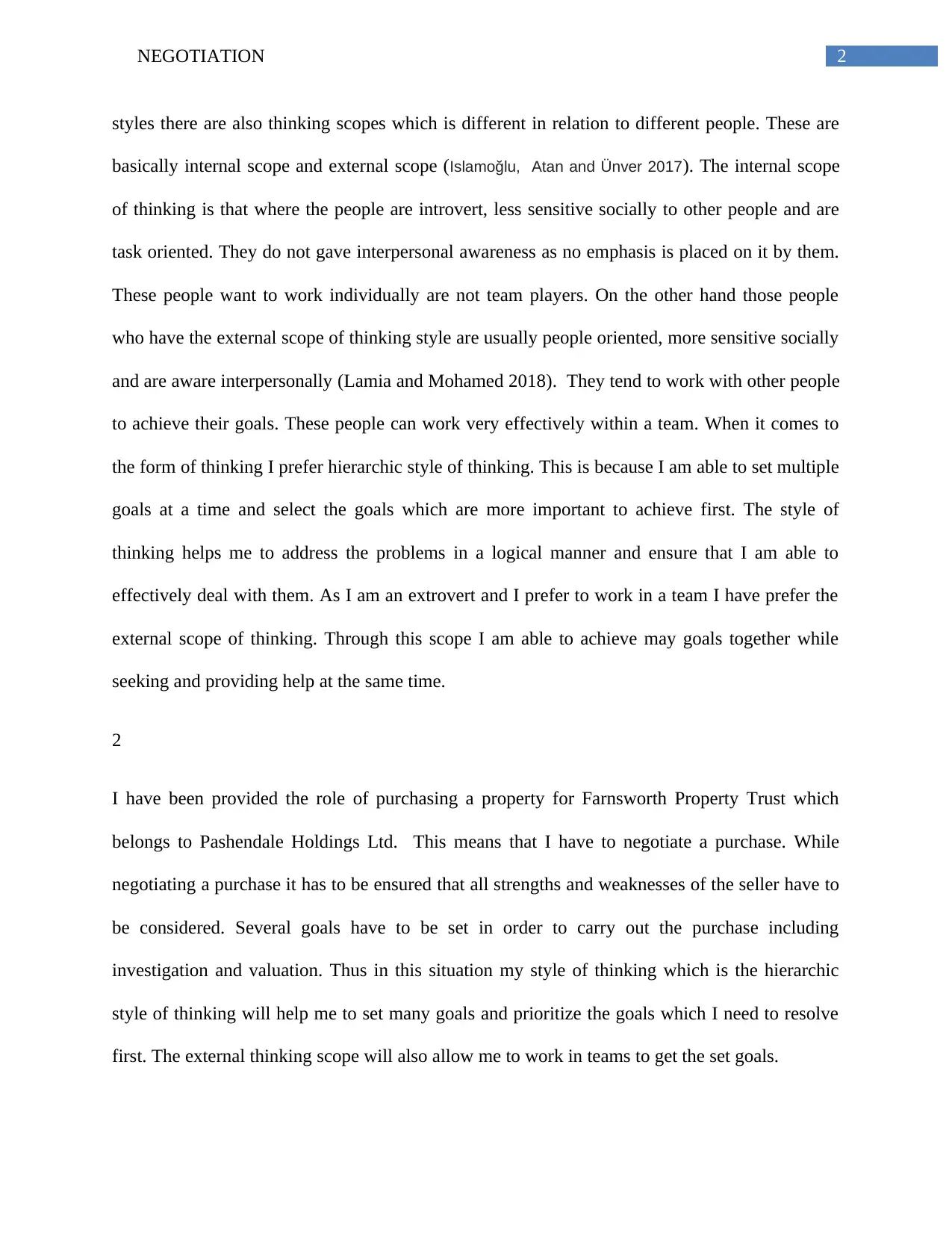
2NEGOTIATION
styles there are also thinking scopes which is different in relation to different people. These are
basically internal scope and external scope (Islamoğlu, Atan and Ünver 2017). The internal scope
of thinking is that where the people are introvert, less sensitive socially to other people and are
task oriented. They do not gave interpersonal awareness as no emphasis is placed on it by them.
These people want to work individually are not team players. On the other hand those people
who have the external scope of thinking style are usually people oriented, more sensitive socially
and are aware interpersonally (Lamia and Mohamed 2018). They tend to work with other people
to achieve their goals. These people can work very effectively within a team. When it comes to
the form of thinking I prefer hierarchic style of thinking. This is because I am able to set multiple
goals at a time and select the goals which are more important to achieve first. The style of
thinking helps me to address the problems in a logical manner and ensure that I am able to
effectively deal with them. As I am an extrovert and I prefer to work in a team I have prefer the
external scope of thinking. Through this scope I am able to achieve may goals together while
seeking and providing help at the same time.
2
I have been provided the role of purchasing a property for Farnsworth Property Trust which
belongs to Pashendale Holdings Ltd. This means that I have to negotiate a purchase. While
negotiating a purchase it has to be ensured that all strengths and weaknesses of the seller have to
be considered. Several goals have to be set in order to carry out the purchase including
investigation and valuation. Thus in this situation my style of thinking which is the hierarchic
style of thinking will help me to set many goals and prioritize the goals which I need to resolve
first. The external thinking scope will also allow me to work in teams to get the set goals.
styles there are also thinking scopes which is different in relation to different people. These are
basically internal scope and external scope (Islamoğlu, Atan and Ünver 2017). The internal scope
of thinking is that where the people are introvert, less sensitive socially to other people and are
task oriented. They do not gave interpersonal awareness as no emphasis is placed on it by them.
These people want to work individually are not team players. On the other hand those people
who have the external scope of thinking style are usually people oriented, more sensitive socially
and are aware interpersonally (Lamia and Mohamed 2018). They tend to work with other people
to achieve their goals. These people can work very effectively within a team. When it comes to
the form of thinking I prefer hierarchic style of thinking. This is because I am able to set multiple
goals at a time and select the goals which are more important to achieve first. The style of
thinking helps me to address the problems in a logical manner and ensure that I am able to
effectively deal with them. As I am an extrovert and I prefer to work in a team I have prefer the
external scope of thinking. Through this scope I am able to achieve may goals together while
seeking and providing help at the same time.
2
I have been provided the role of purchasing a property for Farnsworth Property Trust which
belongs to Pashendale Holdings Ltd. This means that I have to negotiate a purchase. While
negotiating a purchase it has to be ensured that all strengths and weaknesses of the seller have to
be considered. Several goals have to be set in order to carry out the purchase including
investigation and valuation. Thus in this situation my style of thinking which is the hierarchic
style of thinking will help me to set many goals and prioritize the goals which I need to resolve
first. The external thinking scope will also allow me to work in teams to get the set goals.
⊘ This is a preview!⊘
Do you want full access?
Subscribe today to unlock all pages.

Trusted by 1+ million students worldwide
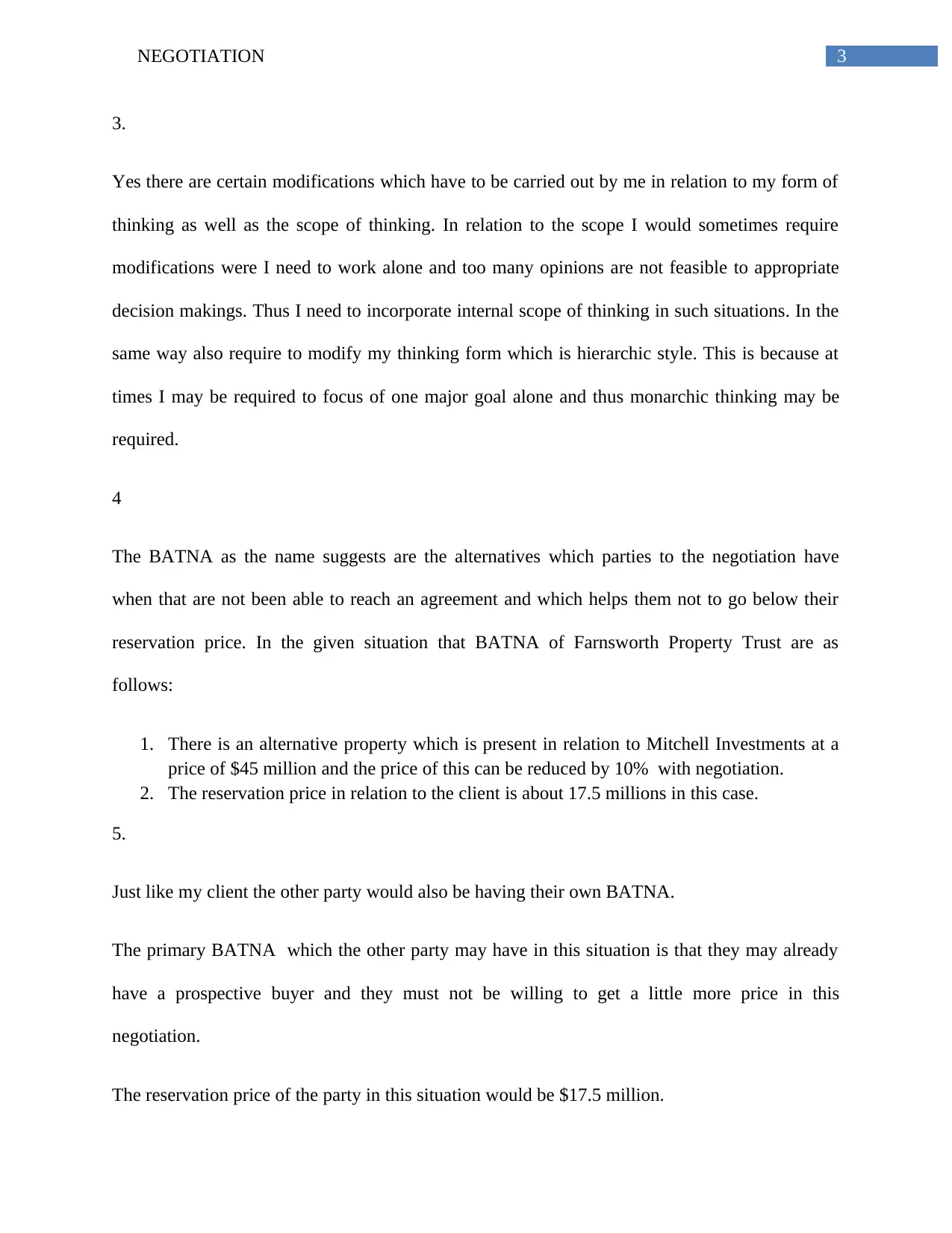
3NEGOTIATION
3.
Yes there are certain modifications which have to be carried out by me in relation to my form of
thinking as well as the scope of thinking. In relation to the scope I would sometimes require
modifications were I need to work alone and too many opinions are not feasible to appropriate
decision makings. Thus I need to incorporate internal scope of thinking in such situations. In the
same way also require to modify my thinking form which is hierarchic style. This is because at
times I may be required to focus of one major goal alone and thus monarchic thinking may be
required.
4
The BATNA as the name suggests are the alternatives which parties to the negotiation have
when that are not been able to reach an agreement and which helps them not to go below their
reservation price. In the given situation that BATNA of Farnsworth Property Trust are as
follows:
1. There is an alternative property which is present in relation to Mitchell Investments at a
price of $45 million and the price of this can be reduced by 10% with negotiation.
2. The reservation price in relation to the client is about 17.5 millions in this case.
5.
Just like my client the other party would also be having their own BATNA.
The primary BATNA which the other party may have in this situation is that they may already
have a prospective buyer and they must not be willing to get a little more price in this
negotiation.
The reservation price of the party in this situation would be $17.5 million.
3.
Yes there are certain modifications which have to be carried out by me in relation to my form of
thinking as well as the scope of thinking. In relation to the scope I would sometimes require
modifications were I need to work alone and too many opinions are not feasible to appropriate
decision makings. Thus I need to incorporate internal scope of thinking in such situations. In the
same way also require to modify my thinking form which is hierarchic style. This is because at
times I may be required to focus of one major goal alone and thus monarchic thinking may be
required.
4
The BATNA as the name suggests are the alternatives which parties to the negotiation have
when that are not been able to reach an agreement and which helps them not to go below their
reservation price. In the given situation that BATNA of Farnsworth Property Trust are as
follows:
1. There is an alternative property which is present in relation to Mitchell Investments at a
price of $45 million and the price of this can be reduced by 10% with negotiation.
2. The reservation price in relation to the client is about 17.5 millions in this case.
5.
Just like my client the other party would also be having their own BATNA.
The primary BATNA which the other party may have in this situation is that they may already
have a prospective buyer and they must not be willing to get a little more price in this
negotiation.
The reservation price of the party in this situation would be $17.5 million.
Paraphrase This Document
Need a fresh take? Get an instant paraphrase of this document with our AI Paraphraser

4NEGOTIATION
6.
The zone of possible agreement in the given situation will initiate at a price of around $17.5
million. This is because the there may be various prospective buyers for the property. The ways
of enhancing the ZOPA include understanding the position of the other party so that it can be
found out that they actually have any prospective buyers who are willing to pay a higher price
that what has been offered by the client (Whited et al 2017).
6.
The zone of possible agreement in the given situation will initiate at a price of around $17.5
million. This is because the there may be various prospective buyers for the property. The ways
of enhancing the ZOPA include understanding the position of the other party so that it can be
found out that they actually have any prospective buyers who are willing to pay a higher price
that what has been offered by the client (Whited et al 2017).
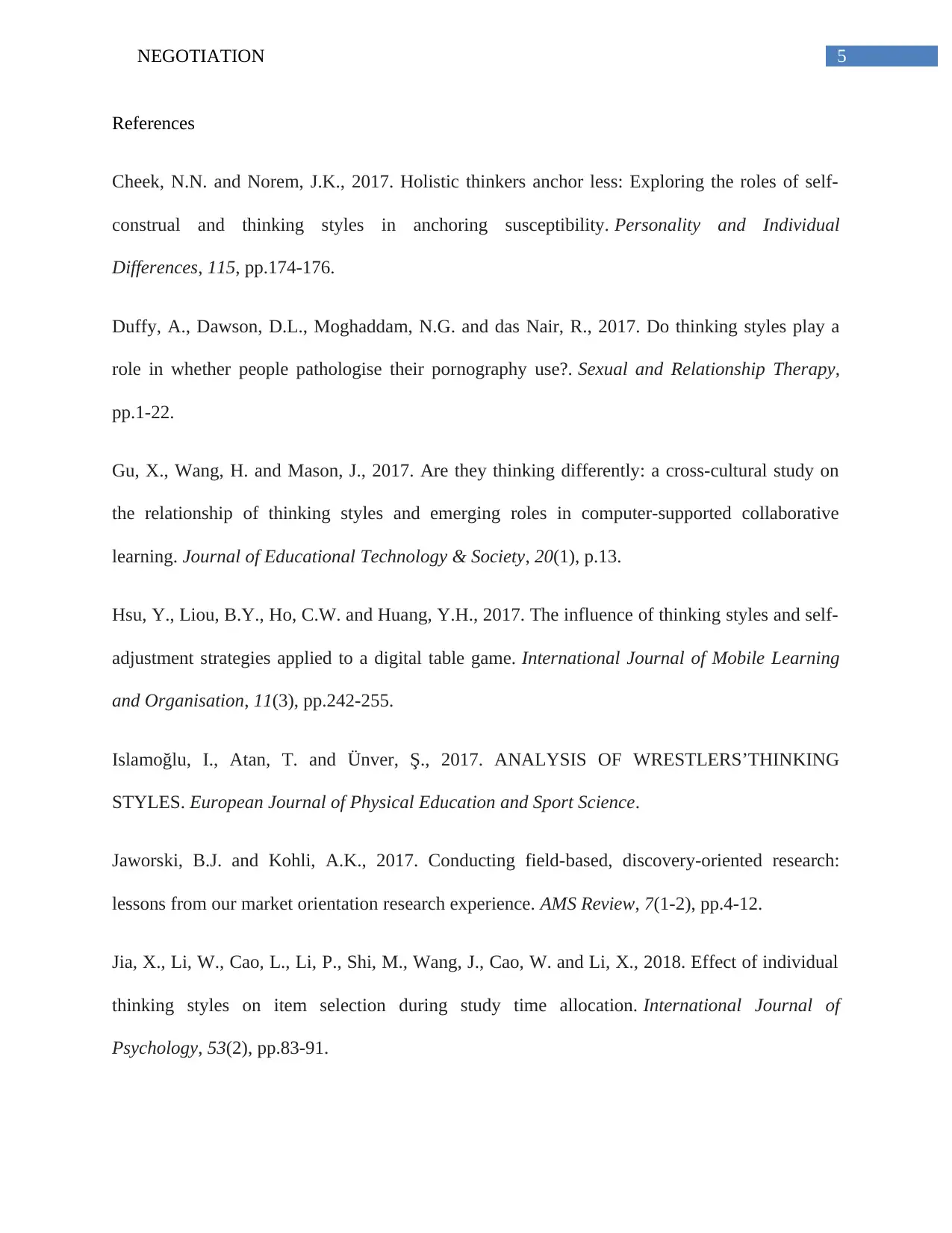
5NEGOTIATION
References
Cheek, N.N. and Norem, J.K., 2017. Holistic thinkers anchor less: Exploring the roles of self-
construal and thinking styles in anchoring susceptibility. Personality and Individual
Differences, 115, pp.174-176.
Duffy, A., Dawson, D.L., Moghaddam, N.G. and das Nair, R., 2017. Do thinking styles play a
role in whether people pathologise their pornography use?. Sexual and Relationship Therapy,
pp.1-22.
Gu, X., Wang, H. and Mason, J., 2017. Are they thinking differently: a cross-cultural study on
the relationship of thinking styles and emerging roles in computer-supported collaborative
learning. Journal of Educational Technology & Society, 20(1), p.13.
Hsu, Y., Liou, B.Y., Ho, C.W. and Huang, Y.H., 2017. The influence of thinking styles and self-
adjustment strategies applied to a digital table game. International Journal of Mobile Learning
and Organisation, 11(3), pp.242-255.
Islamoğlu, I., Atan, T. and Ünver, Ş., 2017. ANALYSIS OF WRESTLERS’THINKING
STYLES. European Journal of Physical Education and Sport Science.
Jaworski, B.J. and Kohli, A.K., 2017. Conducting field-based, discovery-oriented research:
lessons from our market orientation research experience. AMS Review, 7(1-2), pp.4-12.
Jia, X., Li, W., Cao, L., Li, P., Shi, M., Wang, J., Cao, W. and Li, X., 2018. Effect of individual
thinking styles on item selection during study time allocation. International Journal of
Psychology, 53(2), pp.83-91.
References
Cheek, N.N. and Norem, J.K., 2017. Holistic thinkers anchor less: Exploring the roles of self-
construal and thinking styles in anchoring susceptibility. Personality and Individual
Differences, 115, pp.174-176.
Duffy, A., Dawson, D.L., Moghaddam, N.G. and das Nair, R., 2017. Do thinking styles play a
role in whether people pathologise their pornography use?. Sexual and Relationship Therapy,
pp.1-22.
Gu, X., Wang, H. and Mason, J., 2017. Are they thinking differently: a cross-cultural study on
the relationship of thinking styles and emerging roles in computer-supported collaborative
learning. Journal of Educational Technology & Society, 20(1), p.13.
Hsu, Y., Liou, B.Y., Ho, C.W. and Huang, Y.H., 2017. The influence of thinking styles and self-
adjustment strategies applied to a digital table game. International Journal of Mobile Learning
and Organisation, 11(3), pp.242-255.
Islamoğlu, I., Atan, T. and Ünver, Ş., 2017. ANALYSIS OF WRESTLERS’THINKING
STYLES. European Journal of Physical Education and Sport Science.
Jaworski, B.J. and Kohli, A.K., 2017. Conducting field-based, discovery-oriented research:
lessons from our market orientation research experience. AMS Review, 7(1-2), pp.4-12.
Jia, X., Li, W., Cao, L., Li, P., Shi, M., Wang, J., Cao, W. and Li, X., 2018. Effect of individual
thinking styles on item selection during study time allocation. International Journal of
Psychology, 53(2), pp.83-91.
⊘ This is a preview!⊘
Do you want full access?
Subscribe today to unlock all pages.

Trusted by 1+ million students worldwide
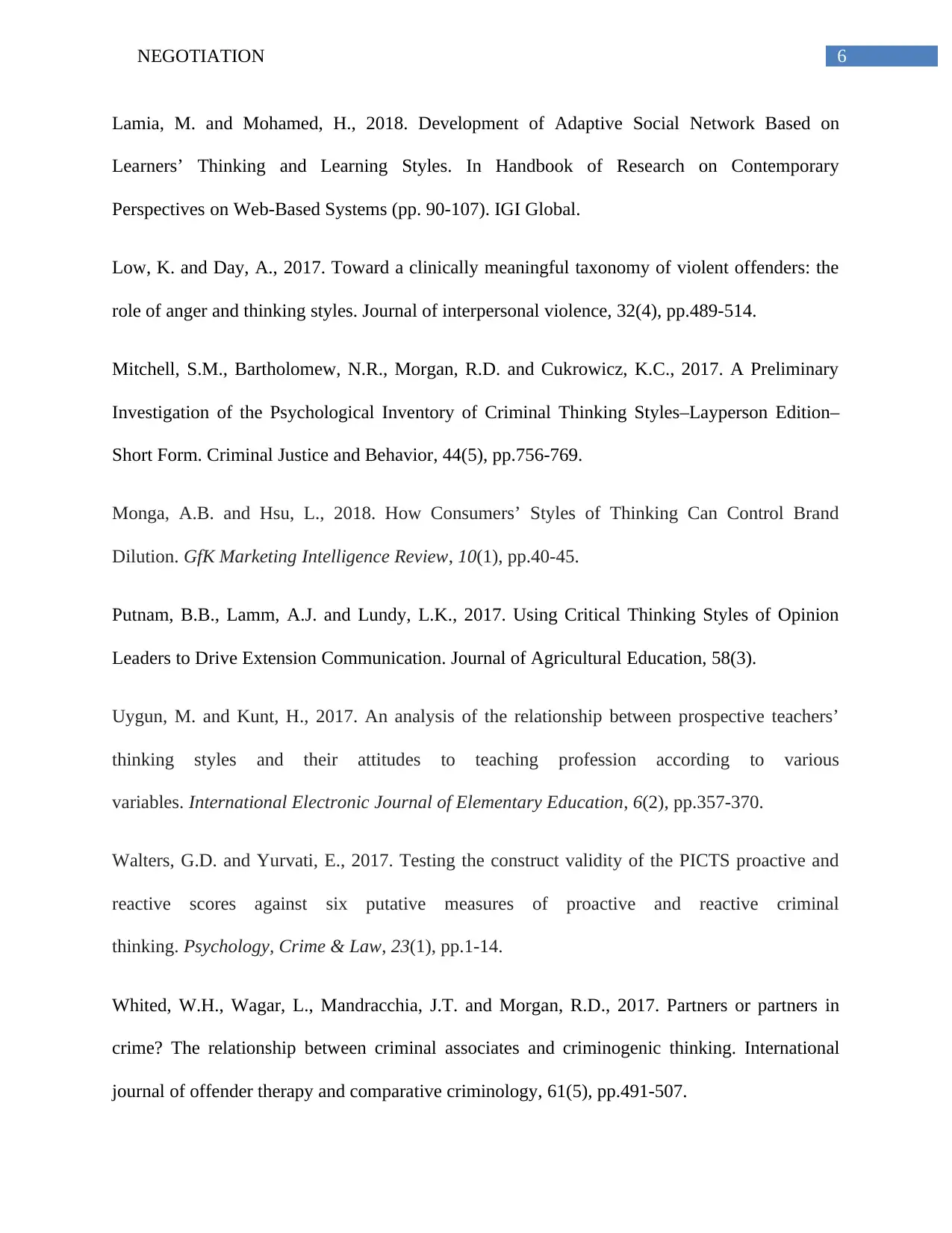
6NEGOTIATION
Lamia, M. and Mohamed, H., 2018. Development of Adaptive Social Network Based on
Learners’ Thinking and Learning Styles. In Handbook of Research on Contemporary
Perspectives on Web-Based Systems (pp. 90-107). IGI Global.
Low, K. and Day, A., 2017. Toward a clinically meaningful taxonomy of violent offenders: the
role of anger and thinking styles. Journal of interpersonal violence, 32(4), pp.489-514.
Mitchell, S.M., Bartholomew, N.R., Morgan, R.D. and Cukrowicz, K.C., 2017. A Preliminary
Investigation of the Psychological Inventory of Criminal Thinking Styles–Layperson Edition–
Short Form. Criminal Justice and Behavior, 44(5), pp.756-769.
Monga, A.B. and Hsu, L., 2018. How Consumers’ Styles of Thinking Can Control Brand
Dilution. GfK Marketing Intelligence Review, 10(1), pp.40-45.
Putnam, B.B., Lamm, A.J. and Lundy, L.K., 2017. Using Critical Thinking Styles of Opinion
Leaders to Drive Extension Communication. Journal of Agricultural Education, 58(3).
Uygun, M. and Kunt, H., 2017. An analysis of the relationship between prospective teachers’
thinking styles and their attitudes to teaching profession according to various
variables. International Electronic Journal of Elementary Education, 6(2), pp.357-370.
Walters, G.D. and Yurvati, E., 2017. Testing the construct validity of the PICTS proactive and
reactive scores against six putative measures of proactive and reactive criminal
thinking. Psychology, Crime & Law, 23(1), pp.1-14.
Whited, W.H., Wagar, L., Mandracchia, J.T. and Morgan, R.D., 2017. Partners or partners in
crime? The relationship between criminal associates and criminogenic thinking. International
journal of offender therapy and comparative criminology, 61(5), pp.491-507.
Lamia, M. and Mohamed, H., 2018. Development of Adaptive Social Network Based on
Learners’ Thinking and Learning Styles. In Handbook of Research on Contemporary
Perspectives on Web-Based Systems (pp. 90-107). IGI Global.
Low, K. and Day, A., 2017. Toward a clinically meaningful taxonomy of violent offenders: the
role of anger and thinking styles. Journal of interpersonal violence, 32(4), pp.489-514.
Mitchell, S.M., Bartholomew, N.R., Morgan, R.D. and Cukrowicz, K.C., 2017. A Preliminary
Investigation of the Psychological Inventory of Criminal Thinking Styles–Layperson Edition–
Short Form. Criminal Justice and Behavior, 44(5), pp.756-769.
Monga, A.B. and Hsu, L., 2018. How Consumers’ Styles of Thinking Can Control Brand
Dilution. GfK Marketing Intelligence Review, 10(1), pp.40-45.
Putnam, B.B., Lamm, A.J. and Lundy, L.K., 2017. Using Critical Thinking Styles of Opinion
Leaders to Drive Extension Communication. Journal of Agricultural Education, 58(3).
Uygun, M. and Kunt, H., 2017. An analysis of the relationship between prospective teachers’
thinking styles and their attitudes to teaching profession according to various
variables. International Electronic Journal of Elementary Education, 6(2), pp.357-370.
Walters, G.D. and Yurvati, E., 2017. Testing the construct validity of the PICTS proactive and
reactive scores against six putative measures of proactive and reactive criminal
thinking. Psychology, Crime & Law, 23(1), pp.1-14.
Whited, W.H., Wagar, L., Mandracchia, J.T. and Morgan, R.D., 2017. Partners or partners in
crime? The relationship between criminal associates and criminogenic thinking. International
journal of offender therapy and comparative criminology, 61(5), pp.491-507.
Paraphrase This Document
Need a fresh take? Get an instant paraphrase of this document with our AI Paraphraser

7NEGOTIATION
Yuan, W., Zhang, L.F. and Fu, M., 2017. Thinking styles and academic stress coping among
Chinese secondary school students. Educational Psychology, 37(8), pp.1015-1025.
Yuan, W., Zhang, L.F. and Fu, M., 2017. Thinking styles and academic stress coping among
Chinese secondary school students. Educational Psychology, 37(8), pp.1015-1025.
1 out of 8
Related Documents
Your All-in-One AI-Powered Toolkit for Academic Success.
+13062052269
info@desklib.com
Available 24*7 on WhatsApp / Email
![[object Object]](/_next/static/media/star-bottom.7253800d.svg)
Unlock your academic potential
Copyright © 2020–2025 A2Z Services. All Rights Reserved. Developed and managed by ZUCOL.





